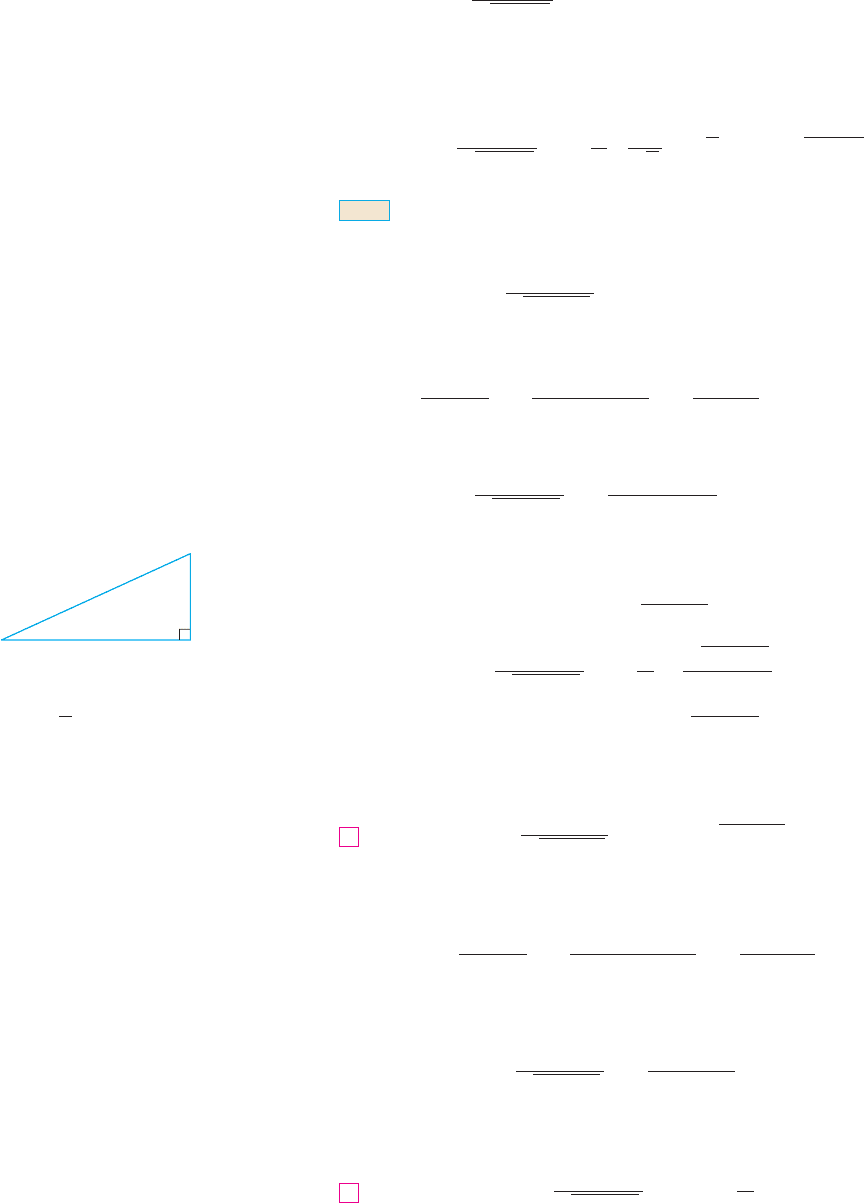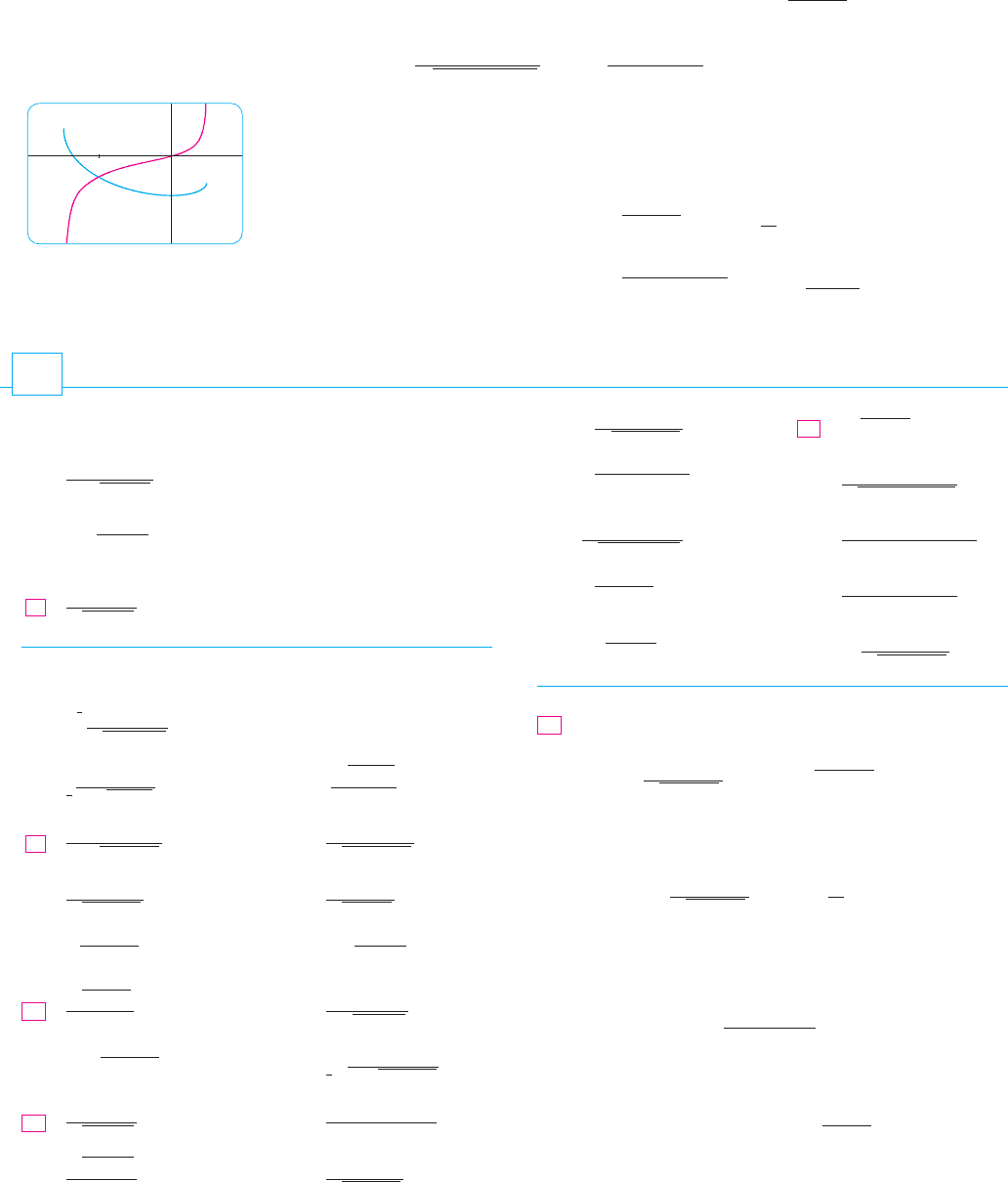Stewart J. Calculus
Подождите немного. Документ загружается.


53. 54.
Find the average value of the function on
the interval .
56. Evaluate by four methods:
(a) the substitution
(b) the substitution
(c) the identity
(d) integration by parts
Explain the different appearances of the answers.
57–58 Find the area of the region bounded by the given curves.
57.
58. , ,
;
59–60 Use a graph of the integrand to guess the value of the
integral. Then use the methods of this section to prove that your
guess is correct.
59. 60.
61–64 Find the volume obtained by rotating the region bounded
by the given curves about the specified axis.
, , ; about the -axis
62. , , ; about the -axis
63. , , ; about
64. , , ; about
65. A particle moves on a straight line with velocity function
. Find its position function
if
66. Household electricity is supplied in the form of alternating
current that varies from V to V with a frequency
of 60 cycles per second (Hz). The voltage is thus given by
the equation
where is the time in seconds. Voltmeters read the RMS
(root-mean-square) voltage, which is the square root of the
average value of over one cycle.
(a) Calculate the RMS voltage of household current.
(b) Many electric stoves require an RMS voltage of 220 V.
Find the corresponding amplitude needed for the volt-
age .E!t" ! A sin!120
&
t"
A
%E!t"&
2
t
E!t" ! 155 sin!120
&
t"
"155155
f !0" ! 0.
s ! f !t"
v!t" ! sin
'
t cos
2
'
t
y ! "10 ( x (
&
#3y ! cos xy ! sec x
y ! 10 ( x (
&
#4y ! cos xy ! sin x
x0 ( x (
&
y ! 0y ! sin
2
x
x
&
#2 ( x (
&
y ! 0y ! sin x
61.
y
2
0
sin 2
&
x cos 5
&
x dx
y
2
&
0
cos
3
x dx
&
#4 ( x ( 5
&
#4y ! cos
3
xy ! sin
3
x
"
&
#4 ( x (
&
#4y ! cos
2
x,y ! sin
2
x,
sin 2x ! 2 sin x cos x
u ! sin x
u ! cos x
x sin x cos x dx
%"
&
,
&
&
f !x" ! sin
2
x cos
3
x
55.
y
sec
4
x
2
dx
y
sin 3x sin 6x dx
17. 18.
19. 20.
21. 22.
24.
25. 26.
27. 28.
30.
31. 32.
33. 34.
35. 36.
37. 38.
39. 40.
41. 42.
44.
45. 46.
47. 48.
49.
50. If , express the value of
in terms of .
;
51–54 Evaluate the indefinite integral. Illustrate, and check that
your answer is reasonable, by graphing both the integrand and its
antiderivative (taking .
51. 52.
y
sin
3
x cos
4
x dx
y
x sin
2
!x
2
" dx
C ! 0"
I
x
&
#4
0
tan
8
x sec x dx
x
&
#4
0
tan
6
x sec x dx ! I
y
t sec
2
!t
2
" tan
4
!t
2
" dt
y
dx
cos x " 1
y
1 " tan
2
x
sec
2
x
dx
y
cos x ! sin x
sin 2x
dx
y
sin 5
$
sin
$
d
$
y
cos
&
x cos 4
&
x dx
y
sin 8x cos 5x dx
43.
y
&
#3
&
#6
csc
3
x dx
y
csc x dx
y
csc
4
x cot
6
x dx
y
cot
3
%
csc
3
%
d
%
y
&
#2
&
#4
cot
3
x dx
y
&
#2
&
#6
cot
2
x dx
y
sin
)
cos
3
)
d
)
y
x sec x tan x dx
y
tan
2
x sec x dx
y
tan
3
$
cos
4
$
d
$
y
tan
6
!ay" dy
y
tan
5
x dx
y
&
#3
0
tan
5
x sec
6
x dx
y
tan
3
x sec x dx
29.
y
tan
3
!2x" sec
5
!2x" dx
y
&
#3
0
tan
5
x sec
4
x dx
y
&
#4
0
sec
4
$
tan
4
$
d
$
y
sec
6
t dt
y
!tan
2
x ! tan
4
x" dx
y
tan
2
x dx
23.
y
&
#2
0
sec
4
!t#2" dt
y
sec
2
x tan x dx
y
cos
2
x sin 2x dx
y
cos x ! sin 2x
sin x
dx
y
cot
5
$
sin
4
$
d
$
y
cos
2
x tan
3
x dx
502
|| ||
CHAPTER 8 TECHNIQUES OF INTEGRATION

SECTION 8.3 TRIGONOMETRIC SUBSTITUTION
|| ||
503
70. A finite Fourier series is given by the sum
Show that the th coefficient is given by the formula
a
m
!
1
&
y
&
"
&
f !x" sin mx dx
a
m
m
! a
1
sin x ! a
2
sin 2x ! * * * ! a
N
sin Nx
f !x" !
'
N
n!1
a
n
sin nx
67–69 Prove the formula, where and are positive integers.
67.
68.
69.
y
&
"
&
cos mx cos nx dx !
(
0
&
if m " n
if m ! n
y
&
"
&
sin mx sin nx dx !
(
0
&
if m " n
if m ! n
y
&
"
&
sin mx cos nx dx ! 0
nm
TRIGONOMETRIC SUBSTITUTION
In finding the area of a circle or an ellipse, an integral of the form arises,
where . If it were , the substitution would be effective
but, as it stands, is more difficult. If we change the variable from to by
the substitution , then the identity allows us to get rid of the
root sign because
Notice the difference between the substitution (in which the new variable is
a function of the old one) and the substitution (the old variable is a function of
the new one).
In general we can make a substitution of the form by using the Substitution
Rule in reverse. To make our calculations simpler, we assume that has an inverse func-
tion; that is, is one-to-one. In this case, if we replace by and by in the Substitution
Rule (Equation 5.5.4), we obtain
This kind of substitution is called inverse substitution.
We can make the inverse substitution provided that it defines a one-to-one
function. This can be accomplished by restricting to lie in the interval .
In the following table we list trigonometric substitutions that are effective for the given
radical expressions because of the specified trigonometric identities. In each case the restric-
tion on is imposed to ensure that the function that defines the substitution is one-to-one.
(These are the same intervals used in Section 7.6 in defining the inverse functions.)
TABLE OF TRIGONOMETRIC SUBSTITUTIONS
$
%"
&
#2,
&
#2&
$
x ! a sin
$
y
f !x" dx !
y
f !t!t""t+!t" dt
txxut
t
x ! t!t"
x ! a sin
$
u ! a
2
" x
2
s
a
2
" x
2
!
s
a
2
" a
2
sin
2
$
!
s
a
2
!1 " sin
2
$
"
!
s
a
2
cos
2
$
! a
$
cos
$
$
1 " sin
2
$
! cos
2
$
x ! a sin
$
$
xx
s
a
2
" x
2
dx
u ! a
2
" x
2
x x
s
a
2
" x
2
dxa , 0
x
s
a
2
" x
2
dx
8.3
Expression Substitution Identity
sec
2
$
" 1 ! tan
2
$
x ! a sec
$
, 0 (
$
-
&
2
or
&
(
$
-
3
&
2
s
x
2
" a
2
1 ! tan
2
$
! sec
2
$
x ! a tan
$
, "
&
2
-
$
-
&
2
s
a
2
! x
2
1 " sin
2
$
! cos
2
$
x ! a sin
$
, "
&
2
(
$
(
&
2
s
a
2
" x
2

EXAMPLE 1
Evaluate .
SOLUTION
Let , where . Then and
(Note that because .) Thus the Inverse Substitution Rule
gives
Since this is an indefinite integral, we must return to the original variable . This can be
done either by using trigonometric identities to express in terms of or
by drawing a diagram, as in Figure 1, where is interpreted as an angle of a right tri-
angle. Since , we label the opposite side and the hypotenuse as having lengths
and . Then the Pythagorean Theorem gives the length of the adjacent side as ,
so we can simply read the value of from the figure:
(Although in the diagram, this expression for is valid even when .)
Since , we have and so
M
EXAMPLE 2
Find the area enclosed by the ellipse
SOLUTION
Solving the equation of the ellipse for , we get
Because the ellipse is symmetric with respect to both axes, the total area is four times
the area in the first quadrant (see Figure 2). The part of the ellipse in the first quadrant is
given by the function
and so
1
4
A !
y
a
0
b
a
s
a
2
" x
2
dx
0 ( x ( ay !
b
a
s
a
2
" x
2
A
y ! .
b
a
s
a
2
" x
2
or
y
2
b
2
! 1 "
x
2
a
2
!
a
2
" x
2
a
2
y
x
2
a
2
!
y
2
b
2
! 1
V
y
s
9 " x
2
x
2
dx ! "
s
9 " x
2
x
" sin
"1
)
x
3
*
! C
$
! sin
"1
!x#3"sin
$
! x#3
$
-
0cot
$
$
, 0
cot
$
!
s
9 " x
2
x
cot
$
s
9 " x
2
3
xsin
$
! x#3
$
sin
$
! x#3cot
$
x
! "cot
$
"
$
! C
!
y
!csc
2
$
" 1" d
$
!
y
cos
2
$
sin
2
$
d
$
!
y
cot
2
$
d
$
y
s
9 " x
2
x
2
dx !
y
3 cos
$
9 sin
2
$
3 cos
$
d
$
"
&
#2 (
$
(
&
#2cos
$
# 0
s
9 " x
2
!
s
9 " 9 sin
2
$
!
s
9 cos
2
$
! 3
$
cos
$
$
! 3 cos
$
dx ! 3 cos
$
d
$
"
&
#2 (
$
(
&
#2x ! 3 sin
$
y
s
9 " x
2
x
2
dx
V
504
|| ||
CHAPTER 8 TECHNIQUES OF INTEGRATION
3
¨
x
œ„„„„
„
9-≈
F I G U R E 1
sin ¨=
x
3
F I G U R E 2
≈
a@
¥
b@
+ =1
y
0
x
(0,b)
(a,0)
Openmirrors.com

To evaluate this integral we substitute . Then . To change
the limits of integration we note that when , , so ; when ,
, so . Also
since . Therefore
We have shown that the area of an ellipse with semiaxes and is . In particular,
taking , we have proved the famous formula that the area of a circle with
radius is . M
Since the integral in Example 2 was a definite integral, we changed the limits
of integration and did not have to convert back to the original variable .
EXAMPLE 3 Find .
SOLUTION Let . Then and
Thus we have
To evaluate this trigonometric integral we put everything in terms of and :
Therefore, making the substitution , we have
We use Figure 3 to determine that and so
M
y
dx
x
2
s
x
2
! 4
! "
s
x
2
! 4
4x
! C
csc
$
!
s
x
2
! 4
#x
! "
csc
$
4
! C
!
1
4
)
"
1
u
*
! C ! "
1
4 sin
$
! C
y
dx
x
2
s
x
2
! 4
!
1
4
y
cos
$
sin
2
$
d
$
!
1
4
y
du
u
2
u ! sin
$
sec
$
tan
2
$
!
1
cos
$
!
cos
2
$
sin
2
$
!
cos
$
sin
2
$
cos
$
sin
$
y
dx
x
2
s
x
2
! 4
!
y
2 sec
2
$
d
$
4 tan
2
$
! 2 sec
$
!
1
4
y
sec
$
tan
2
$
d
$
s
x
2
! 4
!
s
4!tan
2
$
! 1"
!
s
4 sec
2
$
! 2
$
sec
$
$
! 2 sec
$
dx ! 2 sec
2
$
d
$
x ! 2 tan
$
, "
&
#2
-
$
-
&
#2
y
1
x
2
s
x
2
! 4
dx
V
x
NOTE
&
r
2
r
a ! b ! r
&
abba
! 2ab
[
$
!
1
2
sin 2
$
]
0
&
#2
! 2ab
)
&
2
! 0 " 0
*
!
&
ab
! 4ab
y
&
#2
0
cos
2
$
d
$
! 4ab
y
&
#2
0
1
2
!1 ! cos 2
$
"
d
$
A ! 4
b
a
y
a
0
s
a
2
" x
2
dx ! 4
b
a
y
&
#2
0
a cos
$
! a cos
$
d
$
0 (
$
(
&
#2
s
a
2
" x
2
!
s
a
2
" a
2
sin
2
$
!
s
a
2
cos
2
$
! a
$
cos
$
$
! a cos
$
$
!
&
#2sin
$
! 1
x ! a
$
! 0sin
$
! 0x ! 0
dx ! a cos
$
d
$
x ! a sin
$
SECTION 8.3 TRIGONOMETRIC SUBSTITUTION
|| ||
505
œ„„„„„≈+4
2
¨
x
F I G U R E 3
tan ¨=
x
2

EXAMPLE 4 Find .
SOLUTION It would be possible to use the trigonometric substitution here (as in
Example 3). But the direct substitution is simpler, because then
and
M
Example 4 illustrates the fact that even when trigonometric substitutions are
possible, they may not give the easiest solution. You should look for a simpler method first.
EXAMPLE 5 Evaluate , where .
SOLUTION 1 We let , where or . Then
and
Therefore
The triangle in Figure 4 gives , so we have
Writing , we have
SOLUTION 2 For the hyperbolic substitution can also be used. Using the
identity , we have
Since , we obtain
Since , we have and
y
dx
s
x
2
" a
2
! cosh
"1
)
x
a
*
! C
2
t ! cosh
"1
!x#a"cosh t ! x#a
y
dx
s
x
2
" a
2
!
y
a sinh t dt
a sinh t
!
y
dt ! t ! C
dx ! a sinh t dt
s
x
2
" a
2
!
s
a
2
!cosh
2
t " 1"
!
s
a
2
sinh
2
t
! a sinh t
cosh
2
y " sinh
2
y ! 1
x ! a cosh tx , 0
y
dx
s
x
2
" a
2
! ln
$
x !
s
x
2
" a
2
$
! C
1
1
C
1
! C " ln a
! ln
$
x !
s
x
2
" a
2
$
" ln a ! C
y
dx
s
x
2
" a
2
! ln
+
x
a
!
s
x
2
" a
2
a
+
! C
tan
$
!
s
x
2
" a
2
#a
!
y
sec
$
d
$
! ln
$
sec
$
! tan
$
$
! C
y
dx
s
x
2
" a
2
!
y
a sec
$
tan
$
a tan
$
d
$
s
x
2
" a
2
!
s
a
2
!sec
2
$
" 1"
!
s
a
2
tan
2
$
! a
$
tan
$
$
! a tan
$
dx ! a sec
$
tan
$
d
$
&
-
$
-
3
&
#20
-
$
-
&
#2x ! a sec
$
a , 0
y
dx
s
x
2
" a
2
NOTE
y
x
s
x
2
! 4
dx !
1
2
y
du
s
u
!
s
u
! C !
s
x
2
! 4
! C
du ! 2x dxu ! x
2
! 4
x ! 2 tan
$
y
x
s
x
2
! 4
dx
506
|| ||
CHAPTER 8 TECHNIQUES OF INTEGRATION
F I G U R E 4
sec ¨=
x
a
œ
„„„„„
a
¨
x
≈-a@

Although Formulas 1 and 2 look quite different, they are actually equivalent by
Formula 7.7.4. M
As Example 5 illustrates, hyperbolic substitutions can be used in place of trigo-
nometric substitutions and sometimes they lead to simpler answers. But we usually use
trigonometric substitutions because trigonometric identities are more familiar than hyper-
bolic identities.
EXAMPLE 6 Find .
SOLUTION First we note that so trigonometric substitution
is appropriate. Although is not quite one of the expressions in the table of
trigonometric substitutions, it becomes one of them if we make the preliminary substitu-
tion . When we combine this with the tangent substitution, we have ,
which gives and
When , , so ; when , , so .
Now we substitute so that . When , ; when
. Therefore
M
EXAMPLE 7 Evaluate .
SOLUTION We can transform the integrand into a function for which trigonometric substitu-
tion is appropriate by first completing the square under the root sign:
This suggests that we make the substitution . Then and , so
y
x
s
3 " 2x " x
2
dx !
y
u " 1
s
4 " u
2
du
x ! u " 1du ! dxu ! x ! 1
! 4 " !x ! 1"
2
3 " 2x " x
2
! 3 " !x
2
! 2x" ! 3 ! 1 " !x
2
! 2x ! 1"
y
x
s
3 " 2x " x
2
dx
!
3
16
,
u !
1
u
-
1
1#2
!
3
16
[
(
1
2
! 2
)
" !1 ! 1"
]
!
3
32
y
3
s
3#2
0
x
3
!4x
2
! 9"
3#2
dx ! "
3
16
y
1#2
1
1 " u
2
u
2
du !
3
16
y
1#2
1
!1 " u
"2
"
du
$
!
&
#3, u !
1
2
u ! 1
$
! 0du ! "sin
$
d
$
u ! cos
$
!
3
16
y
&
#3
0
1 " cos
2
$
cos
2
$
sin
$
d
$
!
3
16
y
&
#3
0
tan
3
$
sec
$
d
$
!
3
16
y
&
#3
0
sin
3
$
cos
2
$
d
$
y
3
s
3#2
0
x
3
!4x
2
! 9"
3#2
dx !
y
&
#3
0
27
8
tan
3
$
27 sec
3
$
3
2
sec
2
$
d
$
$
!
&
#3tan
$
!
s
3
x ! 3
s
3
#2
$
! 0tan
$
! 0x ! 0
s
4x
2
! 9
!
s
9 tan
2
$
! 9
! 3 sec
$
dx !
3
2
sec
2
$
d
$
x !
3
2
tan
$
u ! 2x
s
4x
2
! 9
!4x
2
! 9"
3#2
! !
s
4x
2
! 9
)
3
y
3
s
3#2
0
x
3
!4x
2
! 9"
3#2
dx
NOTE
SECTION 8.3 TRIGONOMETRIC SUBSTITUTION
|| ||
507

We now substitute , giving and , so
M ! !
s
3 ! 2x ! x
2
! sin
!1
!
x " 1
2
"
" C
! !
s
4 ! u
2
! sin
!1
!
u
2
"
" C
! !2 cos
#
!
#
" C
!
y
#2 sin
#
! 1$ d
#
y
x
s
3 ! 2x ! x
2
dx !
y
2 sin
#
! 1
2 cos
#
2 cos
#
d
#
s
4 ! u
2
! 2 cos
#
du ! 2 cos
#
d
#
u ! 2 sin
#
508
|| ||
CHAPTER 8 TECHNIQUES OF INTEGRATION
N Figure 5 shows the graphs of the integrand
in Example 7 and its indefinite integral (with
). Which is which?C ! 0
_4
_5
3
2
FIG URE 5
21.
23. 24.
25. 26.
27. 28.
29. 30.
(a) Use trigonometric substitution to show that
(b) Use the hyperbolic substitution to show that
These formulas are connected by Formula 7.7.3.
32. Evaluate
(a) by trigonometric substitution.
(b) by the hyperbolic substitution .
33. Find the average value of , .
34. Find the area of the region bounded by the hyperbola
and the line .x ! 39x
2
! 4y
2
! 36
1 $ x $ 7f #x$ !
s
x
2
! 1%x
x ! a sinh t
y
x
2
#x
2
" a
2
$
3%2
dx
y
dx
s
x
2
" a
2
! sinh
!1
!
x
a
"
" C
x ! a sinh t
y
dx
s
x
2
" a
2
! ln
(
x "
s
x
2
" a
2
)
" C
31.
y
%
%2
0
cos t
s
1 " sin
2
t
dt
y
x
s
1 ! x
4
dx
y
x
2
" 1
#x
2
! 2x " 2$
2
dx
y
s
x
2
" 2x dx
y
x
2
#3 " 4x ! 4x
2
$
3%2
dx
y
x
s
x
2
" x " 1
dx
y
dt
s
t
2
! 6t " 13
y
s
5 " 4x ! x
2
dx
y
1
0
s
x
2
" 1 dx
22.
y
0.6
0
x
2
s
9 ! 25x
2
dx
1–3 Evaluate the integral using the indicated trigonometric sub-
stitution. Sketch and label the associated right triangle.
1. ;
2. ;
;
4 –30 Evaluate the integral.
4.
5. 6.
8.
9. 10.
11. 12.
14.
15. 16.
18.
19. 20.
y
t
s
25 ! t
2
dt
y
s
1 " x
2
x
dx
y
dx
&#ax$
2
! b
2
'
3%2
y
x
s
x
2
! 7
dx
17.
y
2%3
s
2
%3
dx
x
5
s
9x
2
! 1
y
a
0
x
2
s
a
2
! x
2
dx
y
du
u
s
5 ! u
2
y
s
x
2
! 9
x
3
dx
13.
y
1
0
x
s
x
2
" 4
dx
y
s
1 ! 4x
2
dx
y
t
5
s
t
2
" 2
dt
y
dx
s
x
2
" 16
y
x
3
s
x
2
" 100
dx
y
1
x
2
s
25 ! x
2
dx
7.
y
2
1
s
x
2
! 1
x
dx
y
2
s
2
1
t
3
s
t
2
! 1
dt
y
2
s
3
0
x
3
s
16 ! x
2
dx
x ! 3 tan
#
y
x
3
s
x
2
" 9
dx
3.
x ! 3 sin
#
y
x
3
s
9 ! x
2
dx
x ! 3 sec
#
y
1
x
2
s
x
2
! 9
dx
E X E R C I S E S
8.3

SECTION 8.4 INTEGRATION OF RATIONAL FUNCTIONS BY PARTIAL FRACTIONS
|| ||
509
39. (a) Use trigonometric substitution to verify that
(b) Use the figure to give trigonometric interpretations of
both terms on the right side of the equation in part (a).
40. The parabola divides the disk into two
parts. Find the areas of both parts.
41. Find the area of the crescent-shaped region (called a lune)
bounded by arcs of circles with radii and . (See the figure.)
42. A water storage tank has the shape of a cylinder with diam-
eter 10 ft. It is mounted so that the circular cross-sections
are vertical. If the depth of the water is 7 ft, what percentage
of the total capacity is being used?
43. A torus is generated by rotating the circle
about the -axis. Find the volume
enclosed by the torus.
xx
2
" # y ! R$
2
! r
2
R
r
Rr
x
2
" y
2
$ 8y !
1
2
x
2
¨
¨
y=œ
„„„„„
a@-t@
t
0
y
a
x
y
x
0
s
a
2
! t
2
dt !
1
2
a
2
sin
!1
#x%a$ "
1
2
x
s
a
2
! x
2
35. Prove the formula for the area of a sector of
a circle with radius and central angle . [Hint: Assume
and place the center of the circle at the origin
so it has the equation . Then is the sum of the
area of the triangle and the area of the region in
the figure.]
;
36. Evaluate the integral
Graph the integrand and its indefinite integral on the same
screen and check that your answer is reasonable.
;
37. Use a graph to approximate the roots of the equation
. Then approximate the area bounded by
the curve and the line .
38. A charged rod of length produces an electric field at point
given by
where is the charge density per unit length on the rod and
is the free space permittivity (see the figure). Evaluate the
integral to determine an expression for the electric field .
0
x
y
L
P(a,b)
E#P$
&
0
'
E#P$ !
y
L!a
!a
'
b
4
%
&
0
#x
2
" b
2
$
3%2
dx
P#a, b$
L
y ! 2 ! xy ! x
2
s
4 ! x
2
x
2
s
4 ! x
2
! 2 ! x
y
dx
x
4
s
x
2
! 2
O
x
y
RQ
¨
P
PQRPOQ
Ax
2
" y
2
! r
2
0
(
#
(
%
%2
#
r
A !
1
2
r
2
#
INTEGRATION OF RATIONAL FUNCTIONS BY PARTIAL FRACTIONS
In this section we show how to integrate any rational function (a ratio of polynomials) by
expressing it as a sum of simpler fractions, called partial fractions, that we already know
how to integrate. To illustrate the method, observe that by taking the fractions
and to a common denominator we obtain
If we now reverse the procedure, we see how to integrate the function on the right side of
2
x ! 1
!
1
x " 2
!
2#x " 2$ ! #x ! 1$
#x ! 1$#x " 2$
!
x " 5
x
2
" x ! 2
1%#x " 2$
2%#x ! 1$
8.4

this equation:
To see how the method of partial fractions works in general, let’s consider a rational
function
where and are polynomials. It’s possible to express as a sum of simpler fractions
provided that the degree of is less than the degree of . Such a rational function is called
proper. Recall that if
where , then the degree of is and we write .
If is improper, that is, , then we must take the preliminary step
of dividing into (by long division) until a remainder is obtained such that
. The division statement is
where and are also polynomials.
As the following example illustrates, sometimes this preliminary step is all that is
required.
EXAMPLE 1 Find .
SOLUTION Since the degree of the numerator is greater than the degree of the denominator,
we first perform the long division. This enables us to write
M
The next step is to factor the denominator as far as possible. It can be shown that
any polynomial can be factored as a product of linear factors (of the form )
and irreducible quadratic factors (of the form , where ). For
instance, if , we could factor it as
The third step is to express the proper rational function (from Equation 1) as
a sum of partial fractions of the form
Ax " B
#ax
2
" bx " c$
j
or
A
#ax " b$
i
R#x$%Q#x$
Q#x$ ! #x
2
! 4$#x
2
" 4$ ! #x ! 2$#x " 2$#x
2
" 4$
Q#x$ ! x
4
! 16
b
2
! 4ac
(
0ax
2
" bx " c
ax " bQ
Q#x$
!
x
3
3
"
x
2
2
" 2x " 2 ln
(
x ! 1
(
" C
y
x
3
" x
x ! 1
dx !
y
!
x
2
" x " 2 "
2
x ! 1
"
dx
y
x
3
" x
x ! 1
dx
V
RS
f #x$ !
P#x$
Q#x$
! S#x$ "
R#x$
Q#x$
1
deg#R$
(
deg#Q$
R#x$PQ
deg#P$ ) deg#Q$f
deg#P$ ! nnPa
n
" 0
P#x$ ! a
n
x
n
" a
n!1
x
n!1
" * * * " a
1
x " a
0
QP
fQP
f #x$ !
P#x$
Q#x$
! 2 ln
(
x ! 1
(
! ln
(
x " 2
(
" C
y
x " 5
x
2
" x ! 2
dx !
y
!
2
x ! 1
!
1
x " 2
"
dx
510
|| ||
CHAPTER 8 TECHNIQUES OF INTEGRATION
x-1
≈+x
+2
˛-≈
≈+x
≈-x
2x
2x-2
2
˛
+x
)

A theorem in algebra guarantees that it is always possible to do this. We explain the details
for the four cases that occur.
CASE I
N
The denominator Q(x) is a product of distinct linear factors.
This means that we can write
where no factor is repeated (and no factor is a constant multiple of another). In this case
the partial fraction theorem states that there exist constants such that
These constants can be determined as in the following example.
EXAMPLE 2 Evaluate .
SOLUTION Since the degree of the numerator is less than the degree of the denominator, we
don’t need to divide. We factor the denominator as
Since the denominator has three distinct linear factors, the partial fraction decomposition
of the integrand (2) has the form
To determine the values of , , and , we multiply both sides of this equation by the
product of the denominators, , obtaining
Expanding the right side of Equation 4 and writing it in the standard form for polyno-
mials, we get
The polynomials in Equation 5 are identical, so their coefficients must be equal. The
coefficient of on the right side, , must equal the coefficient of on the
left side—namely, 1. Likewise, the coefficients of are equal and the constant terms are
equal. This gives the following system of equations for , , and :
!2A " 2B ! 2C ! !1
3A " 2B ! C ! 2
2A " B " 2C ! 1
CBA
x
x
2
2A " B " 2Cx
2
x
2
" 2x ! 1 ! #2A " B " 2C$x
2
" #3A " 2B ! C $x ! 2A
5
x
2
" 2x ! 1 ! A#2x ! 1$#x " 2$ " Bx#x " 2$ " Cx #2x ! 1$
4
x#2x ! 1$#x " 2$
CBA
x
2
" 2x ! 1
x#2x ! 1$#x " 2$
!
A
x
"
B
2x ! 1
"
C
x " 2
3
2x
3
" 3x
2
! 2x ! x#2x
2
" 3x ! 2$ ! x#2x ! 1$#x " 2$
y
x
2
" 2x ! 1
2x
3
" 3x
2
! 2x
dx
V
R#x$
Q#x$
!
A
1
a
1
x " b
1
"
A
2
a
2
x " b
2
" * * * "
A
k
a
k
x " b
k
2
A
1
, A
2
, . . . , A
k
Q#x$ ! #a
1
x " b
1
$#a
2
x " b
2
$ * * * #a
k
x " b
k
$
SECTION 8.4 INTEGRATION OF RATIONAL FUNCTIONS BY PARTIAL FRACTIONS
|| ||
511
N Another method for finding , , and
is given in the note after this example.
CBA
